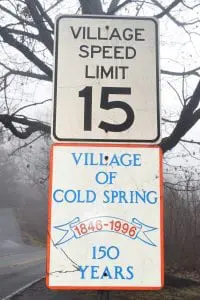Also, fire company asks for delayed funds
Recent confusion over whether the speed limit on Cold Spring streets should be 30 mph per state law has been resolved (it is), but reducing it to the 15 mph stated on a number of signs will take time.
“We all agree 30 mph is ridiculous and dangerous to pedestrians, children and drivers,” but it is clearly mandated by state law, Mayor Dave Merandy said at a Jan. 31 public hearing to consider changes to the Vehicles and Traffic section of the village code.
 Several residents submitted correspondence while others spoke against what they believed was a move by the village board to raise the speed limit from 15 to 30 mph. In reality, Merandy said, the board was proposing an update to align the limit with state law — a law for which no one in Cold Spring has expressed support.
Several residents submitted correspondence while others spoke against what they believed was a move by the village board to raise the speed limit from 15 to 30 mph. In reality, Merandy said, the board was proposing an update to align the limit with state law — a law for which no one in Cold Spring has expressed support.
Several 15 mph signs along village streets have compounded the confusion. Deputy Mayor Marie Early said that a previous village board amended the village code, with the blessing of the village attorney, to lower the speed limit to 15 mph. But state law takes precedence, so the lower speed limit cannot be enforced. School zones are one of few exceptions where the state-imposed 30 mph limit can be reduced by the village.
Trustee Fran Murphy said that previous boards had asked the state seven times to allow the village to lower the speed limit but received no response.
The board will seek assistance from state Assemblywoman Sandy Galef and Senator Sue Serino to petition for a reduced speed limit. Merandy said the effort should include a street-by-street assessment. Some residents suggested Cold Spring join with nearby villages that face a similar situation.
The mayor said the village could erect yellow, diamond-shaped signs to “suggest” slower speeds. They are common on state highways, particularly on turns, although they are not enforceable. It was noted that the village can legally leave the 15 mph signs in place.
The public hearing was closed at the Feb. 7 meeting, after which the trustees approved a number of minor updates to the code related to parking.
Fire company concerns
President Matt Steltz and Chief Steve Smith were part of a delegation from the Cold Spring Fire Company that attended the Feb. 7 meeting to clarify issues that Steltz said may have been “lost in translation.”
Money was at the heart the discussion. The village has been slow to pay $17,039 it owes the fire company, Steltz said, which is needed for gear, fire hoses and air bottles. The CSFC president also noted that the company’s 2017 request for village funds was the same as last year.

The reason for the delay lies in part with Nelsonville, which purchases its fire protection from the village, which in turn passes on that revenue to the fire company minus administrative expenses. Last October, Cold Spring billed Nelsonville $21,679.39 for 2017 fire protection as part of a contract that included the first rate increase since 2012. Nelsonville responded with a check for $20,674.95 on Jan 23. As a result of the discrepancy between the amount billed and the amount paid, the check was not cashed right away.
“Nelsonville didn’t budget for the increase,” Deputy Mayor Marie Early explained, but that didn’t sit well with the CSFC delegation. “The fact that you have a problem with Nelsonville is not our problem,” said former Cold Spring mayor and current CSFC Vice President Ralph Falloon.
“Nelsonville didn’t budget for the increase,” Deputy Mayor Marie Early said. The explanation didn’t sit well with the CSFC delegation. “The fact that you have a problem with Nelsonville is not our problem,” commented former Cold Spring mayor and current CSFC vice president Ralph Falloon. “You do have our money,” Steltz added.
Throughout the discussion Early expressed doubt about the village’s ability to pay the money owed CSFC immediately. “Here’s the problem,” she said. “Do we pay you or do we pay LOSAP?” referring to the premium the village pays into the Length of Service Award Program, the volunteer firefighters’ pension fund. John Landolfi, a veteran firefighter and former CSFC president, responded, “You can’t not pay LOSAP!”
If Early had her doubts, Merandy was emphatic, “We will pay it… I will take care of it tomorrow,” he said. In an email to The Current on Feb. 8, village clerk Mary Saari indicated that a check for $17,039 would be sent to the fire company next week.
The poor condition of the firehouse prompted another discussion. Falloon said many problems identified in 2008 are still unresolved, including a badly decaying roof and the need for a new HVAC system. But Merandy questioned the wisdom of pouring money into the building, which is owned by the village, and encouraged CSFC to revisit plans for a new firehouse. He cautioned the company, however, to be “realistic” in coming up with a proposal that the community could support, that is, well below past estimates in the $5 million to $8 million range.
In other business (Jan. 31) …
- Building Inspector Bill Bujarski met with trustees to discuss ongoing efforts to consolidate the Cold Spring and Philipstown building departments.
- A public hearing was scheduled for 7 p.m. on Feb. 14 at Village Hall to consider a law regarding the technology and fees related to the installation of cellular water meters throughout the village.
- A public hearing will be held at 7 p.m. on Feb. 28 at Village Hall regarding Cold Spring’s participation as part of a Community Choice Aggregate in conjunction with Renewable Highlands, a program which will enable the village to negotiate lower prices for electricity.
- Trustees voted to waive the fee to the Haldane school district for sewer and water hookup.
In other business (Feb. 7) …
- Trustees approved the fireman’s service award point listing for the Cold Spring Fire Company.
- The annual appreciation party for village employees and volunteers will be held from 3 to 6 p.m. on Feb. 25 at the American Legion Hall on Cedar Street.
- The board will hold an executive session at 6 p.m. on Feb. 21 to discuss the employee benefit package.
- Putnam County agreed to collect $44,778 in unpaid taxes on 18 properties on behalf of the village.


The concept of increasing the minimum speed limit for vehicles of all kinds to 30 mph should never have come up. It’s a lose-lose situation. Everyone with a lick of sense is opposed to this idea. Who would win with this terrible idea? Who would benefit?
A bad law at the state level should be opposed, challenged, litigated, petitioned against and repealed, and supporters of such laws should be voted out. Such laws should not be meekly and with defeatism agreed to or complied with by our hitherto trusted village board members.
However, the acting mayor on Jan. 10 tried to slip the code change into the agenda of other, mostly mundane and innocuous items involving the parking code surreptitiously in a poorly attended, bare quorum board meeting held in the dead of winter. I encourage everyone to view the sad truth, shown toward the end of the official video covering the Jan. 10 village board meeting (search for it on YouTube).
If these roads are as narrow and dangerous as locals are saying they are, then raising the speed limit will have no impact on actual travel speeds. Drivers only travel as fast as road conditions comfortably allow. There is no truth to the common “everyone will drive 10 mph over” notion. State law says area-wide (e.g., village/town/city speed limit) cannot be lower than 30 (except New York City, which is 25) and linear (e.g., case-by-case) speed limits cannot be lower than 25 (except New York City, which is 20). These tiny side streets can be raised to 25, not 30. To change this would require the legislature get involved.
Lower speed limits are largely a placebo. I don’t think lowering the state minimum speed limits is a good idea. Villages and cities already abuse their ability to set speed limits by always posting the lowest allowable speed (e.g., when you cross into a city/village and the speed limit drops to 30 mph for no reason), and allowing further reductions will just make New York’s arbitrary speed limits worse.
To paraphrase Dylan: “you don’t need a traffic engineer to know how fast the traffic flows.” And at 30 mph it would be too fast on many of our village side streets, some of which have sidewalks on only one side or no sidewalks at all. Compounding that: steep streets, tight curves, narrow roadways. IMO, “15 is fine”.
While I don’t think anyone is contesting the state DOT’s ability to establish speed limits on state-designated roads (9D and 301), what I find interesting and a bit weird is the number and prevalence of neighboring municipalities of the same class (that is, villages) that also have speed limits on local streets below the 30 mph mark, irrespective of adjacency to school zones. Nelsonville, Fishkill, Wappingers and Highland Falls all have local streets pegged at 15 or 20 mph, with Cornwall going as low as 10 mph on Shore Road.
Are all these villages non-compliant with state law? Or are we missing something in the background of its adoption (date unknown to me)? Are they all grandfathered? The first place I would look would be the state legislative bill jacket that would show the measure’s motivation and legislative history, including legislators’ arguments pro and con. It could be that this whole controversy is a big sack of nothing, and apparently has caused some conspiracy theorists maliciously to ascribe evil motivations to diligent village officials.
They probably are non-compliant also. You can post signs but tickets cannot be issued because of non-compliance. Even if non-compliant, if the signs keep drivers from speeding they should be left up. This is another waste of time and energy by the Village Board. The board members and the others should be concerned about where their previous decisions have put the Village. Lawsuits? Who is going to pay for that? I have no intention of allowing the taxpayers to foot the bills for actions that were made to satisfy personal needs of power and gratification.